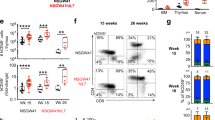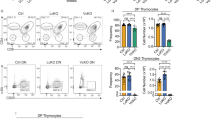Abstract
MOST of the T lymphocytes that populate the immune system develop in the thymus before its involution during late adolescence. Therefore, subsequent losses in T cells caused by HIV infection1, chemotherapy2 or age-related factors3 can greatly diminish immune responses to new antigenic challenge. Here we report the discovery of a thymus-independent pathway of T-cell development that may provide help for T-cell immunodeficiency. We show that expression of an oncostatin M transgene4 in the early T lineage stimulates a dramatic accumulation of immature and mature T cells in lymph nodes. A functional thymus is not required for this effect as reconstitution of nu/nu mice with transgenic bone marrow stimulated a 500-fold increase in Thy-l+ lymph node cells and restored immune responsiveness to allogeneic mouse melanoma cells. This lymphopoietic pathway is not unique to transgenic mice because administration of oncostatin M protein produced a similar response in non-trans-genic mice. These results identify a new pathway of T-cell development and a potential treatment for T-cell immunodeficiency with oncostatin M.
This is a preview of subscription content, access via your institution
Access options
Subscribe to this journal
Receive 51 print issues and online access
$199.00 per year
only $3.90 per issue
Buy this article
- Purchase on Springer Link
- Instant access to full article PDF
Prices may be subject to local taxes which are calculated during checkout
Similar content being viewed by others
References
Roederer, M. Nature Med. 1, 621–622 (1995).
Mackall, C. L. et al. N. Engl. J. Med. 332, 143–149 (1995).
Fransceschi, C., Monti, D., Sansoni, P. & Cossarizza, A. Immunol. Today 16, 12–16 (1995).
Malik, N. et al. Mol. Cell. Biol. 15, 2349–2358 (1995).
Bruce, A. G., Linsley, P. S. & Rose, T. M. Progr. Growth Factor Res. 4, 157–170 (1992).
Yoshimura, A. et al. EMBO J. 15, 1055–1063 (1996).
Kisielow, P. & von Boehmer, H. Adv. Immunol. 58, 87–209 (1995).
Saint-Ruf, C. et al. Science 266, 1208–1212 (1994).
Li, Y. et al. J. Immunol. 153, 421–428 (1994).
Gearing, D. P. et al. Science 255, 1434–1437 (1992).
Bernad, A. et al. Immunity 1, 725–731 (1994).
Escary, J. L. et al. Nature 363, 361–364 (1993).
Shen, M. M. et al. EMBO J. 13, 1375–1385 (1994).
Yoshida, K. et al. Proc. Natl Acad. Sci. USA 93, 407–411 (1996).
Wallace, P. M. et al. Ann. NY Acad. Sci. 762, 42–54 (1995).
Rocha, B., Guy-Grand, D. & Vassalli, P. Curr. Opin. Immunol. 7, 235–242 (1995).
Author information
Authors and Affiliations
Rights and permissions
About this article
Cite this article
Clegg, C., Rulffes, J., Wallace, P. et al. Regulation of an extrathymic T-cell development pathway by oncostatin M. Nature 384, 261–263 (1996). https://doi.org/10.1038/384261a0
Received:
Accepted:
Issue Date:
DOI: https://doi.org/10.1038/384261a0
This article is cited by
-
Osteoimmunology: oncostatin M as a pleiotropic regulator of bone formation and resorption in health and disease
BoneKEy Reports (2014)
-
Thymic microenvironments for T cell differentiation and selection
Nature Immunology (2006)
-
Therapeutic targets for HIV-1 infection in the host proteome
Retrovirology (2005)
-
Strategies to enhance T-cell reconstitution in immunocompromised patients
Nature Reviews Immunology (2004)
-
Another way to generate T cells?
Nature Medicine (1997)
Comments
By submitting a comment you agree to abide by our Terms and Community Guidelines. If you find something abusive or that does not comply with our terms or guidelines please flag it as inappropriate.



